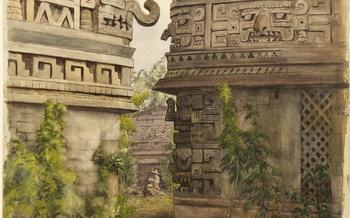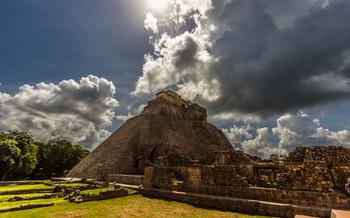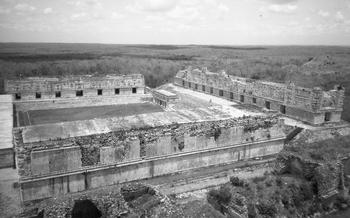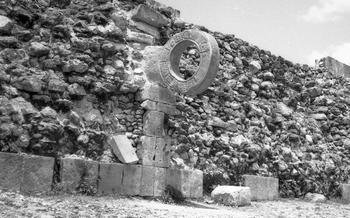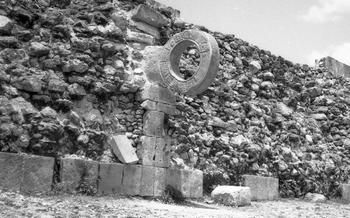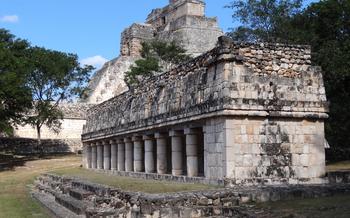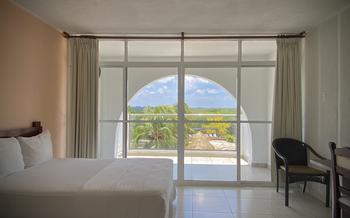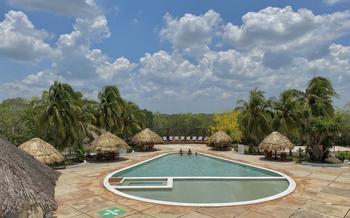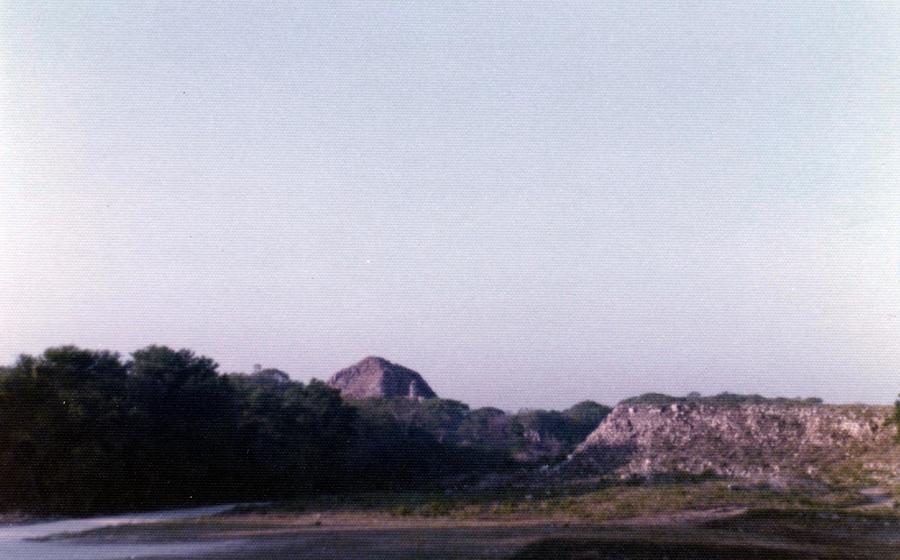
La Vieja, Uxmal
- The Ruins of Uxmal
- La Vieja
- Exploring La Vieja
- Other Highlights of Uxmal
- Planning Your Visit
- What to Wear and Bring
- Where to Stay
- Where to Eat
- Things to Do in the Area
- Safety Tips
- Cultural Etiquette
- History of Uxmal
- Legends and Myths
- Flora and Fauna
- Insider Tip
The Ruins of Uxmal
Nestled in the heart of the Yucatán Peninsula, Uxmal stands as a testament to the architectural prowess of the ancient Maya civilization. Built between the 7th and 10th centuries, this city flourished as a thriving economic and political center, leaving behind a treasure trove of well-preserved structures that captivate visitors to this day.
Historical Significance
Uxmal's history is deeply intertwined with the rise and fall of the Maya civilization. Once ruled by the powerful Xiú dynasty, the city reached its peak during the Late Classic period, boasting a population of over 20,000 inhabitants. Its strategic location along trade routes and its mastery of water management techniques contributed to its prosperity and influence.
Architectural Features
The architectural splendor of Uxmal is evident in its towering pyramids, intricate carvings, and sophisticated building techniques. The city's most iconic structure, the Pyramid of the Magician, stands as a testament to the Maya's advanced understanding of mathematics and engineering. The Nunnery Quadrangle, with its beautifully preserved friezes depicting mythical creatures and scenes from everyday life, offers a glimpse into the artistic and religious traditions of the Maya.
Preservation Efforts
Recognizing the immense cultural and historical significance of Uxmal, significant efforts have been made to preserve and protect this ancient city. Archaeological excavations and restoration projects have been meticulously carried out to ensure the longevity of these structures for future generations.
Visitor Facilities
To enhance the visitor experience, Uxmal offers a range of amenities and services. Well-maintained paths and walkways allow for easy exploration of the site, while informative signs provide historical context and insights into the significance of each structure. A visitor center equipped with restrooms, a museum, and a gift shop caters to the needs of tourists and history enthusiasts alike.
La Vieja
La Vieja, also known as the "Old Woman," is one of the most iconic structures within the Uxmal ruins. This pyramid-shaped building is an architectural marvel, showcasing the advanced construction techniques and artistic prowess of the Maya civilization.
Location: La Vieja is prominently situated in the southwest corner of the Uxmal site, making it one of the first structures that visitors encounter as they explore the ancient city. Its strategic placement suggests its importance as a ceremonial or religious center.
History: The exact history and purpose of La Vieja remain shrouded in mystery. Archaeologists believe it was constructed around the 6th or 7th century AD during the Late Classic period of Maya civilization. The building underwent several modifications and expansions over time, reflecting the changing needs and beliefs of the Maya people.
Architectural Style: La Vieja stands out for its unique architectural style, combining elements of Puuc and Chenes styles. The lower portion of the structure features a Puuc-style facade adorned with intricate masks of the rain god Chaac, while the upper portion exhibits the distinctive Chenes style with its elaborate geometric designs and serpent motifs.
Significance: La Vieja holds immense historical and cultural significance. It represents the fusion of different Maya architectural styles and serves as a testament to the artistry and ingenuity of the ancient Maya builders. The pyramid also provides valuable insights into the religious beliefs and practices of the Maya civilization, as it is believed to have been used for ceremonial rituals and offerings to the gods.
Exploring La Vieja
Self-guided tour: - Explore La Vieja at your own pace, allowing ample time to admire the intricate carvings and architectural details. - Take advantage of the informative signs and maps provided throughout the site to learn more about the history and significance of the structures. - Enjoy the tranquility and solitude of the site, especially during early mornings or late afternoons, when the crowds are smaller.
Guided tour options: - Opt for a guided tour to gain deeper insights into the history, architecture, and cultural significance of La Vieja. - Knowledgeable guides can provide fascinating stories and anecdotes that bring the ancient Maya civilization to life. - Guided tours are available in various languages and can be booked in advance or arranged upon arrival at the site.
Photography tips: - Capture the stunning beauty of La Vieja through photographs, ensuring to use the right lighting conditions for the best results. - Experiment with different angles and perspectives to showcase the intricate details of the carvings and the grandeur of the structures. - Use a tripod for stability and to avoid blurry images, especially in low-light conditions.
Accessibility: - La Vieja is generally accessible to visitors, with paved paths and ramps leading to the main structures. - However, some areas may be uneven or challenging for those with limited mobility. - Visitors with disabilities are encouraged to contact the site's administration in advance to inquire about specific accessibility features and assistance.
Other Highlights of Uxmal
Beyond La Vieja, Uxmal boasts a treasure trove of other awe-inspiring structures that showcase the architectural prowess of the ancient Maya. Among them, the majestic Pyramid of the Magician stands tall, its imposing silhouette dominating the skyline. With its steep, stepped sides and intricate carvings, this pyramid is a testament to the engineering genius of the Maya. Ascend its towering height to enjoy breathtaking panoramic views of the surrounding jungle and ancient city.
Equally captivating is the Nunnery Quadrangle, an elegant complex of four buildings arranged around a central courtyard. Its well-preserved facades feature intricate stucco decorations depicting scenes from Maya mythology and daily life. Take your time to explore each building, admiring the artistry and symbolism that adorn their walls.
For a glimpse into the sporting prowess of the ancient Maya, visit the Great Ball Court. This vast, rectangular field was once the stage for intense ball games, a ritual deeply ingrained in Maya culture. Imagine the roar of the crowd as players maneuvered the heavy rubber ball using only their hips and elbows, striving for victory and divine favor.
Last but not least, don't miss the House of the Turtles, a small but exquisite building adorned with intricate carvings of turtles. These sacred creatures held deep significance in Maya mythology, representing fertility, creation, and the connection between the earth and the underworld. Marvel at the artistry of these carvings, which seem to come alive under the warm glow of the tropical sun.
Planning Your Visit
When planning your visit to Uxmal, there are a few things to keep in mind to make the most of your experience:
-
Best time to visit: The best time to visit Uxmal is during the dry season, which runs from November to April. During this time, the weather is pleasant, with warm days and cool nights.
-
How to get there: Uxmal is located about 60 miles south of Mérida, the capital of Yucatán. The easiest way to get there is by taking a guided tour from Mérida. Alternatively, you can rent a car and drive yourself, or take a bus from Mérida to the town of Uxmal.
-
Entrance fees: The entrance fee to Uxmal is 500 pesos for adults and 250 pesos for children. Guided tours typically cost around 1000 pesos per person.
-
Guided tour options: Guided tours of Uxmal are available in English and Spanish. Tours typically last for about two hours and cover the main highlights of the site, including La Vieja, the Pyramid of the Magician, and the Nunnery Quadrangle.
What to Wear and Bring
Visiting Uxmal requires proper preparation in terms of clothing and essentials. The weather in Uxmal is generally hot and humid, so light and breathable clothing is recommended. Natural fabrics like cotton and linen are ideal, as they allow the skin to breathe and help absorb sweat. It's essential to wear comfortable shoes as you'll be doing a lot of walking on uneven surfaces. Avoid wearing flip-flops or sandals, as they can be hazardous on the ancient ruins.
Sun protection is paramount. The sun can be intense in Uxmal, so wearing a hat, sunglasses, and sunscreen with a high SPF is crucial. Reapply sunscreen frequently, especially after swimming or sweating.
Don't forget to bring plenty of water to stay hydrated, as there are limited water sources within the ruins. You can purchase bottled water or bring your own reusable bottle and refill it at the visitor center. Snacks are also a good idea to keep your energy levels up throughout the day.
A camera is a must-have to capture the stunning beauty of Uxmal's architecture and the surrounding nature. A pair of binoculars can also be useful for spotting wildlife or getting a closer look at the intricate details of the ruins.
Where to Stay
When planning a visit to Uxmal, there are several options available for accommodation. Within the archaeological site itself, visitors can find the Hacienda Uxmal, an elegant hotel that offers a unique experience of staying amidst the ancient ruins. The hotel boasts charming rooms, a swimming pool, and a restaurant serving delicious Mayan cuisine.
For those seeking more budget-friendly options, the nearby town of Santa Elena offers a range of hotels and hostels. These accommodations provide a comfortable stay with basic amenities and are within easy reach of the archaeological site.
Travelers looking for a more immersive experience can opt for vacation rentals or Airbnb options in the area. These rentals often offer the opportunity to stay in a traditional Mayan house or a charming hacienda, providing a glimpse into the local culture and lifestyle.
Where to Eat
In the small town of Uxmal, dining options are limited but charming. La Hacienda Uxmal is a popular choice for its traditional Yucatecan cuisine and its beautiful setting within a restored hacienda. For a more casual meal, try the Restaurante El Pueblito, which serves up delicious tacos, tortas, and other Mexican favorites.
If you're looking for something a bit different, head to the Restaurante Maya in the nearby town of Santa Elena. This restaurant specializes in Mayan cuisine, using traditional recipes and ingredients to create dishes that are both authentic and delicious.
For a truly unique dining experience, don't miss the Mercado Municipal in Mérida. This bustling market is home to a variety of food stalls selling everything from fresh produce to handmade tortillas to traditional Mayan dishes. Here, you can sample the local cuisine and soak up the vibrant atmosphere of this historic city.
Things to Do in the Area
Beyond the captivating ruins of Uxmal, the region offers a wealth of diverse experiences that will enthrall any traveler. Immerse yourself in the refreshing waters of nearby cenotes, natural sinkholes that provide a unique and invigorating swimming experience. Explore the rich cultural heritage of the Mayan villages, where you can witness traditional crafts, savor authentic cuisine, and learn about the ancient Mayan way of life.
Discover the grandeur of haciendas, sprawling estates that once belonged to wealthy landowners, and step back in time to the colonial era by visiting nearby colonial cities with their charming architecture and vibrant ambiance. Whether you seek adventure, relaxation, or cultural immersion, the area surrounding Uxmal promises an unforgettable journey.
Safety Tips
Visiting Uxmal is generally safe, but like any tourist destination, it's essential to be aware of your surroundings and take the necessary precautions. Here are some safety tips to keep in mind:
-
General safety precautions:
- Avoid walking alone at night, especially in unlit areas.
- Be wary of pickpockets and petty theft, particularly in crowded areas.
- Keep your valuables safe by using a money belt or keeping them in a secure location.
- Be cautious when exchanging money, and avoid doing so on the street.
-
Avoiding scams:
- Be skeptical of unsolicited offers for tours or services.
- Do not buy tickets or souvenirs from street vendors.
- Be aware of fake tour guides and always ask for identification.
- Negotiate prices for goods and services before making a purchase.
-
Staying hydrated:
- The Yucatan Peninsula can be very hot and humid, so it's essential to stay hydrated.
- Drink plenty of water throughout the day, especially when exploring the ruins.
- Avoid sugary drinks and alcohol, which can dehydrate you.
-
Respecting local customs:
- Be respectful of local customs and traditions.
- Dress modestly, especially when visiting religious sites.
- Avoid loud noises and disruptive behavior.
- Be mindful of your body language and gestures.
Cultural Etiquette
When visiting Uxmal and interacting with the local Maya people, it is important to be mindful of cultural etiquette.
-
Greetings: A simple "Hola" (hello) with a nod or handshake is the customary greeting.
-
Tipping: While not mandatory, tipping is appreciated for good service. A small tip of 10-15% is customary in restaurants and for tour guides.
-
Bargaining: Bargaining is common in markets and with street vendors. Be polite and respectful, and don't be afraid to walk away if the price is too high.
-
Dress code: Dress modestly and respectfully when visiting Mayan communities. Avoid wearing revealing or beachwear in sacred or ceremonial areas.
History of Uxmal
Uxmal's history is as captivating as its ruins. During the Pre-Columbian period, it flourished as the capital of the powerful Maya state of Uxmal, reaching its peak between 700 and 1000 AD. The Maya built magnificent structures, including La Vieja, using advanced construction techniques and intricate designs that reflected their cosmology and religious beliefs.
After the decline of the Maya civilization, Uxmal was abandoned and gradually reclaimed by the jungle. In the 16th century, Spanish conquistadors arrived in the region and encountered the impressive ruins, sparking interest in the site's history and significance.
In the 19th century, Uxmal gained international recognition when renowned explorers and archaeologists, such as John Lloyd Stephens and Frederick Catherwood, visited and documented the site. Their writings and illustrations helped bring Uxmal to the attention of the world and paved the way for further exploration and preservation efforts.
In the 20th century, archaeological research intensified at Uxmal, shedding light on the city's history, culture, and daily life. Excavations revealed intricate hieroglyphic inscriptions, elaborate sculptures, and artifacts that provided valuable insights into the Maya civilization.
Today, Uxmal stands as a testament to the ingenuity and artistry of the Maya. It is a UNESCO World Heritage Site and one of the most visited archaeological sites in Mexico, attracting visitors from around the globe who come to marvel at the grandeur and mystery of this ancient city.
Legends and Myths
Uxmal is steeped in a rich tapestry of legends and myths that have been passed down through generations. One of the most enduring tales is the story of the dwarf. According to legend, a diminutive Mayan king named Ah Zuytok was determined to build the tallest pyramid in the world. He enlisted the help of a powerful sorcerer who agreed to grant his wish on one condition: the king had to sacrifice his only daughter. Ah Zuytok reluctantly agreed, and the sorcerer used his magic to raise the pyramid in a single night. However, the king was so grief-stricken over the loss of his daughter that he refused to climb the pyramid. Instead, he leaped to his death from the top, and his spirit is said to haunt the ruins to this day.
Another popular legend is associated with the ball game, which was a sacred ritual among the Maya. It is said that the losing team's captain was sacrificed to the gods in order to ensure a bountiful harvest. The Great Ball Court at Uxmal is one of the largest and best-preserved in the Maya world, and it is believed that many sacrificial games took place here.
The ruins of Uxmal are also said to hold a hidden treasure. According to legend, the Maya buried vast amounts of gold and jewels within the ruins, and many have searched for it over the years. However, no one has ever been able to find the treasure, and it remains one of the most enduring mysteries of Uxmal.
Finally, Uxmal is also home to a number of prophecies. One of the most famous prophecies is said to have been made by a Mayan priest named Chilam Balam. He predicted that a great cataclysm would occur in the year 2012, but the world would be spared if enough people prayed and meditated. While the world did not end in 2012, many people still believe that the prophecies of Chilam Balam are true, and they continue to visit Uxmal in hopes of receiving guidance and inspiration.
Flora and Fauna
Uxmal is home to a diverse array of flora and fauna. The lush vegetation surrounding the ruins includes native trees such as the ceiba, mahogany, and sapodilla, as well as a variety of tropical flowers and plants. The wildlife in the area is equally diverse, with species such as monkeys, toucans, parrots, and iguanas commonly spotted.
For nature enthusiasts, Uxmal offers a unique opportunity to combine history and wildlife viewing. Visitors can take a guided tour of the ruins, led by an expert naturalist who can point out the various plant and animal species found in the area. Birdwatching is also a popular activity, as Uxmal is home to over 200 different species of birds.
The conservation of Uxmal's natural environment is of utmost importance. The local community and the archaeological authorities are working together to protect the delicate ecosystem of the area. Sustainable tourism practices are being implemented to minimize the impact of tourism on the environment. Visitors are encouraged to respect the wildlife and their habitat, and to dispose of their waste responsibly.
By promoting sustainable tourism and raising awareness about the importance of conservation, Uxmal can continue to be a thriving destination for both history buffs and nature lovers alike.
Insider Tip
-
Visiting Uxmal during the equinox: During the spring and autumn equinoxes, the sun aligns perfectly with the main axis of the Pyramid of the Magician, creating a stunning visual effect. Plan your visit to coincide with this celestial event for a truly memorable experience.
-
Attending the light and sound show: In the evenings, Uxmal comes alive with a spectacular light and sound show that narrates the history and legends of the ancient city. It's a captivating way to learn about the site's past and immerse yourself in its mystical atmosphere.
-
Exploring the nearby ruins of Kabah: Just a short drive from Uxmal, you'll find the ruins of Kabah, another impressive Maya city. While smaller in size, Kabah boasts some unique architectural features, including the Codz Poop, a remarkable palace with a distinctive façade adorned with masks of the rain god Chaac.
-
Trying the local cuisine: Don't miss the chance to savor the delicious local cuisine of Uxmal. Sample traditional dishes like cochinita pibil, a slow-roasted pork dish cooked in banana leaves, or panuchos, fried tortillas topped with beans, meat, and pickled onions.

